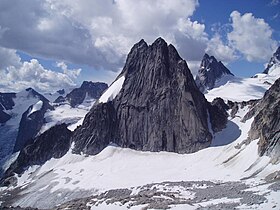The Bugaboos
| The Bugaboos | |
|---|---|

Snowpatch Spire in the Bugaboos
|
|
| Highest point | |
| Peak | Howser Spire |
| Elevation | 3,412 m (11,194 ft) |
| Coordinates | 50°44′45″N 116°47′21″W / 50.74583°N 116.78917°WCoordinates: 50°44′45″N 116°47′21″W / 50.74583°N 116.78917°W |
| Geography | |
| Country | Canada |
| Province | British Columbia |
| Parent range | Purcell Mountains |
| Geology | |
| Type of rock | Granite batholith |
The Bugaboos are a mountain range in the Purcell Mountains of eastern British Columbia, Canada. The granite spires of the group are a popular mountaineering destination. The Bugaboos are protected within Bugaboo Provincial Park.
The Bugaboos are located in the northwestern extreme of the Purcells in the Columbia Mountains, in the south-east of the province. The nearest towns are Radium and Golden. They are commonly subdivided into four divisions: the Bugaboo Glacier Peaks, and the Eastern, Central, and Western Spires. The nearby Vowell and Conrad Groups are usually considered separate from the Bugaboos.
Located in the snow- and rain-heavy "Columbia Wet Belt", this section of the Purcells is subject to heavy erosion and large, active glaciers. Originally covered in weaker rock, glaciation eventually revealed the granodiorite batholiths which form the group's distinctive spires. The surrounding rock is approximately 600 million to 1 billion years old, while the Bugaboo intrusion dates to 135 million years ago. The igneous intrusion cooled slowly, forming the crystalline structure of the hard granite found today.
Originally named the "Nunataks", the Bugaboo spires were first noted by a surveying expedition in the late 1800s. Mining brought the first Europeans to the region with a small, ill-fated gold rush occurring in 1895 and 1896 near Bugaboo Falls. The area was prospected and staked, but the meager deposits turned out to be mostly pyrite and galena. The name "Bugaboo" originated from this rush; the term was used by prospectors for a "dead-end".
Climbers became interested in the group shortly after. In 1910, an expedition led by Thomas Longstaff and surveyor Arthur Oliver Wheeler entered the area. They were guided by renowned European climber Conrad Kain. Kain would return to the area six years later and pioneer many difficult climbing routes. The Austrian climber described his route up Bugaboo Spire as his most difficult Canadian ascent, more challenging than his celebrated route up Mount Robson, the highest peak in the Canadian Rockies. Along with Albert and Bess McCarthy and others, Kain would pioneer first ascents of North Howser, Marmolata, and Crescent Spires.
...
Wikipedia
